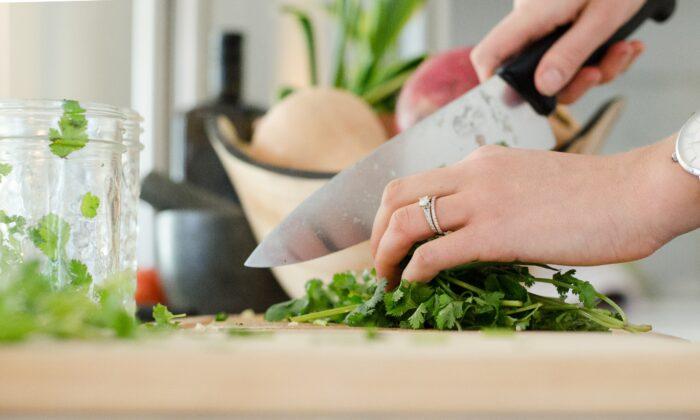Want your children to eat their vegetables? Without a doubt, the best way to get a child to eat a vegetable is to have them grow it. That one-on-one experience is inspiring to see as a child learns about beauty, food, and patience when learning how to grow for themselves.
Having a small kitchen or potager garden—even a garden planted in small containers—can stimulate more vegetable eating. Definitively, a kitchen or potager garden is where fruits, herbs, and vegetables are grown for use in cooking and eating. Growing your own vegetables integrates exercise, fresh air, sunshine, therapeutic scents, and direct contact with soil.
Although you might find a traditional potager in the ground, it’s absolutely possible to grow a kitchen garden by utilizing elevated beds, living walls, and container pots.

Kitchen Garden Tips
- Grow It Organically: It’s assumed that all the foods used in your kitchen garden will be consumed by your family, so growing organically is absolutely critical to reducing chemical exposure.
- Sunshine Levels: Potager gardens perform best when receiving full sun, or six to eight hours of sun per day. However, it’s possible to grow vegetables in shade (see breakout box).
- The Soil Secret: Vegetables and herbs need to be rotated seasonally and the soil needs to be replenished by adding plenty of compost and new material annually.
- Holding Moisture: Mulch your gardens to prevent weeds and hold in moisture.
- Watering Is Important: Vegetables, fruits, and herbs need more water. For low maintenance watering, install a drip system in the garden.
- Keeping It Neat: Succession planting helps you harvest more food. If a plant has stopped producing or has been harvested, try planting a new row of seeds or add a new plant in order to stretch out seasonal food production.
Growing in Shade or Part Shade
Most herbs and vegetables prefer full sun. However, many gardeners, especially those who live in urban centers, feel thwarted in creating a kitchen garden because of lower light conditions. While it can be more of a challenge to grow in the shade, it is quite possible.If you can grow a few plants in shadier circumstances, it means you can grow in areas that typically aren’t used for gardening such as balconies, along fence lines, close to shady or covered patios or walkways, and between tall buildings.
A great way to grow in less space is to create a living wall, which is easy to create simply by using window boxes mounted to a wall. Both living walls and container gardens tuck into small spaces—even shady spaces—quite nicely.

Produce such as leafy greens sometimes remain smaller when grown in heavy shade, so planting more closely together with expectations of smaller plants means you can still grow just as much of a potager crop while working to harvest younger produce.
Additionally, the rule to remember when planting in shade is “No Sun = No Fruits and No Roots.” In other words, plants such as potatoes, which are roots, and tomatoes, which are fruits, produce abundantly in full sun but are less likely to produce an abundant harvest in heavier shade. A convenient list of shade-tolerant herbs and vegetables that can grow well in a potager garden can be found below.
No matter where you garden—in the ground, elevated beds, living walls, container gardens, or raised beds—growing as much nutrient-rich food as you possibly can with your family is advantageous. Have your family pitch in to assemble the gardens. From adding soil to planting seeds or plants, their involvement in the process of planting and growing will keep them engaged.
That specific engagement will encourage them to want to try the produce after harvest. If a toddler or a teenager tries a food and likes it, they are likely to try it again and again.
Another aspect to the family planting and growing a kitchen garden together is that, hopefully, there will be an overabundance of food. While the food can be frozen or canned, a more positive step for a small child to see is food donation, so take your child along to your local food pantry. Involving your family in the growing-to-eating-to-giving process makes a kitchen garden so much more than just a garden—it’s a learning experience that will last a lifetime.

Shade-Tolerant Herbs and Vegetables
Growing vegetables and herbs on a part-shade balcony, patio, or traditional in-ground kitchen garden is possible. Part shade is defined as approximately two to four hours of sun per day. Leafy herbs and vegetables perform better in shady conditions, while fruiting and rooting plants don’t do as well.Here is a partial list of shade-tolerant plants, to give you and your family more gardening options: arugula, basil, beans, beet greens, bok choy, broccoli, cabbage, celery, collards, cauliflower, Chinese cabbage, corn mâche, endive, kale, kohlrabi, leeks, lettuces, leafy herbs, Malabar spinach, mizuna, rhubarb, mustard greens, Swiss chard, peas, scallions, spinach, tatsoi, and turnip greens.





